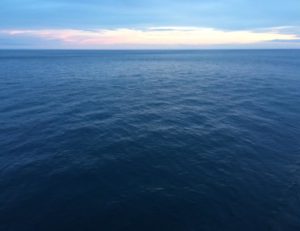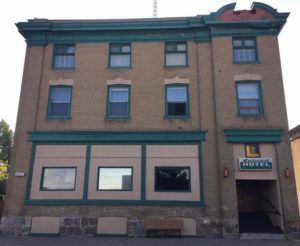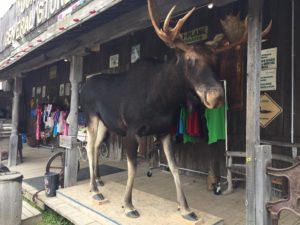
Observing–and I mean slowed-down, patient observing–puts me in the best frame of mind for writing. It involves slowing down, and noting what I am seeing, hearing, feeling, smelling, and tasting. Once I am in that deep observation mode, I only have to begin writing my observations to become swept into the flow of writing.
Elizabeth Bishop is a person to look to on this subject. Her poems observe and describe so deeply that she almost doesn’t have to do anything more than that. She doesn’t reach for meaning. She arrives at it through her subject, language and image choices. For instance, here is her poem, “The Bight,” written in 1949 on the event of her 37th birthday. The final lines are inscribed on her tombstone (she had asked for just the last line, but both were included).
The Bight
At low tide like this how sheer the water is.
White, crumbling ribs of marl protrude and glare
and the boats are dry, the pilings dry as matches.
Absorbing, rather than being absorbed,
the water in the bight doesn’t wet anything,
the color of the gas flame turned as low as possible.
One can smell it turning to gas; if one were Baudelaire
one could probably hear it turning to marimba music.
The little ocher dredge at work off the end of the dock
already plays the dry perfectly off-beat claves.
The birds are outsize. Pelicans crash
into this peculiar gas unnecessarily hard,
it seems to me, like pickaxes,
rarely coming up with anything to show for it,
and going off with humorous elbowings.
Black-and-white man-of-war birds soar
on impalpable drafts
and open their tails like scissors on the curves
or tense them like wishbones, till they tremble.
The frowsy sponge boats keep coming in
with the obliging air of retrievers,
bristling with jackstraw gaffs and hooks
and decorated with bobbles of sponges.
There is a fence of chicken wire along the dock
where, glinting like little plowshares,
the blue-gray shark tails are hung up to dry
for the Chinese-restaurant trade.
Some of the little white boats are still piled up
against each other, or lie on their sides, stove in,
and not yet salvaged, if they ever will be, from the last bad storm,
like torn-open, unanswered letters.
The bight is littered with old correspondences.
Click. Click. Goes the dredge,
and brings up a dripping jawful of marl.
All the untidy activity continues,
awful but cheerful. –Elizabeth Bishop
Hard to read this poem without your mind flying outwards from the untidy activity of the scene she is describing, to the untidy activity of the whole world or cosmos, or perhaps inwards to the untidy activity of your own life.
On my trip from Portland, Oregon, USA, to Lunenburg, Nova Scotia, Canada, in July/August, I posted (on Facebook) at least one photo and one paragraph each day. The posts represented, as I mentioned in my last blog post, a low-stress, public, creative project that allowed me to jump from visual to written in an easy way. It also allowed me to slow down after a very busy and stressful job, contemplate the transition I was making, and let my writer-mind come back to the fore.
I continued the project for the 21 days it took us to cross the continent, not really such a long time. I am not a visual artist or a photographer, so I approached it as a beginner. Some days I would forget to think about what to post that day; other days I would think too much about it. Sometimes I’d be so tired by the end of the day that I would be half asleep while I wrote. It didn’t matter; it was a means to an end. I was not trying to produce masterpieces.
Though as I went along, I got better at it. I developed a keener eye for framing a scene or image, and a keener ear for a story, or the essence of the day.
This one-photo-one-para idea is not my own. Many have done it, but the first I heard of it was from Jonathan Harris. I met Jonathan–who is an internet genius, programmer, painter, and writer–in 2010-2011 when he was looking for a place to write and work. As the Executive Director of Caldera, I was able to find an empty cabin for him at our art center in the Cascade Mountains of Oregon. The project that he did around that time related to him turning 30, and it is called “Today” — click here to see it. He continued it for 440 consecutive days. Whew. It is easy to get lost in his projects and web sites; I urge you to take some time to get lost. His photographs are stunning, his writing compelling, his ideas wild and wonderful.
I took the photo shown at the beginning of this blog from the CAT ferry, on a 6 1/2 hour crossing from Portland, Maine to Yarmouth, Nova Scotia. That is the evening sky. The expanse of water seemed like a new page to me. I loved the simplicity of it. Life has felt too complicated for too long. I felt like a child staring out the window, anticipating our arrival into Nova Scotia and our new life.
I took many, many photographs of water–rivers, lakes, ocean–during our trip, to the point of obsession. Seeing what my eye is drawn to, observing my own trends, I’ve found, feeds my thoughts and my writing. An obvious leap from this is to consider a series of pieces around the images that fascinate you.
I had thought I would load all my photos-and-paras into this blog post. But there’s far too much material. Instead, I offer three posts to give you a taste (slightly edited to condense and to handle tense). I urge you to try it. And I would love to hear your thoughts on the idea, in the comments below.
With love,
Tricia

Day Six (finding a story)
Our sixth day of travel we stayed in Wolseley, a small town of about 750, on the prairies east of Regina (rhymes with vagina, for my American friends). We stayed at the unpolished, unrenovated Leland Hotel, built in 1909, now owned and run by an East Indian family. They told us that the Queen Mother had once stayed in our room (doubtful). There had been an armed robbery there about two months earlier. Two town inhabitants (remember, the town population is 750) walked in with masks on, and guns, and demanded money. The Wild West without much ambition, I thought! Why didn’t they rob a hotel at least a few towns over? I imagine the proprietor might have said “Alright Hank, I know it’s you under that mask…” but I didn’t ask him about it. It seemed impolite to do so (I’m Canadian after all). I asked a guy in the bakery/coffee shop the next day though, and he was shocked that we’d stayed there at all. I believe I still have a bite mark on my thigh, from something that got me in the night, in the Queen Mum’s bed.

Day Eight (pondering identity)
At a roadside grocery with a shady porch that included a TV, I stood with another woman and watched a Canadian channel reporting on USA politics. At the end of the report, the woman turned away saying “Oh my God, I’m so glad I’m Canadian.” For our entire road trip I inhabited my dual identity with some confusion. Always glad to be a Canadian, I had to also remind myself that I was an American citizen too (I applied for that in 2007, when living in Portland, Oregon, so I could vote for Obama in 2008). I felt such a mix of emotion, but mostly this horrible sadness for the United States and a deep disgust for the White House.

Day 15 (pure love)
A big attraction of visiting with my family in Ontario was catching up with Lewyn, my grand-nephew. Grand is an excellent adjective for him; he is a very positive guy, and as you can see from this photograph, he is working on claiming his place in the family band. Lewyn’s favourite phrase is “oh yeah” and as I am in the mode these days of taking everything as a sign or omen, I am making it my phrase too. My fortune is that I’ll be able to watch him grow up, just as I did his Dad, my nephew Matt Snell (also a writer & musician, like so many in my family). Feeling grateful and very lucky.
Oh yeah.
Consider signing up for Tricia’s newsletter. Signup is at the Bottom of her Home Page. Newsletters are very brief; they announce new blog posts (~weekly), any other events, and include What I’m Reading Now and other tidbits.
Oh yeah Tricia! So happy to be keeping in touch with you in this way.
Me too Barb… new communication channels!
Much enjoying these pieces. Thanks Tricia!!
Thanks so much Judith! I am having a great time, and really appreciate your support. And looking forward to seeing you in January for Andrea’s Pastan study group!
Very nice, Tricia. And I’ve found that slowed-down, patient observing also makes for better cooking, at least for me. Love the Bishop poem too (bristling with jackstraw gaffs and hooks…).
Isn’t Bishop amazing? I have yet to visit her town here in Nova Scotia, but it’s on my list. And… you have made a practice of writing to images, on fbook… I love your posts. I wonder what a whole book of them would be like? Scrumptious I would think…